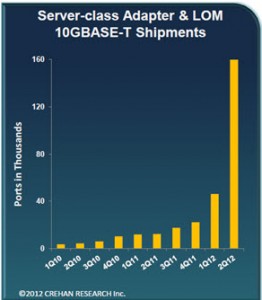For nearly a decade, the primary deployment of 10 Gigabit Ethernet (10GbE) has been using network interface cards (NICs) supporting enhanced Small Form-Factor Pluggable (SFP+) transceivers. The predominant transceivers for 10GbE are Direct Attach (DA) copper, short range optical (10GBASE-SR), and long-range optical (10GBASE-LR). The Direct Attach copper option is the least expensive of the three. However, its adoption has been hampered by two key limitations:
– DA’s range is limited to 7m, and
– because of the SFP+ connector, it is not backward-compatible with existing 1GbE infrastructure using RJ-45 connectors and twisted-pair cabling.
10GBASE-T addresses both of these limitations.
10GBASE-T delivers 10GbE over Category 6, 6A, or 7 cabling terminated with RJ-45 jacks. It is backward-compatible with 1GbE and even 100 Megabit Ethernet. Cat 6A and 7 cables will support up to 100m. The advantages for deployment in an existing data center are obvious. Most existing data centers have already installed twisted pair cabling at Cat 6 rating or better. 10GBASE-T can be added incrementally to these data centers, either in new servers or via NIC upgrades “without forklifts.” New 10GBASE-T ports will operate with all the existing Ethernet infrastructure in place. As switches get upgraded to 10GBASE-T at whatever pace, the only impact will be dramatically improved network bandwidth.
Market adoption of 10GBASE-T accelerated sharply with the first single-chip 10GBASE-T controllers to hit production. This integration become possible because of Moore’s Law advances in semiconductor technology, which also enabled the rise of dense commercial switches supporting 10GBASE-T. Integrating PHY and MAC on a single piece of silicon significantly reduced power consumption. This lower power consumption made fan-less 10GBASE-T NICs possible for the first time. Also, switches supporting 10GBASE-T are now available from Cisco, Dell, Arista, Extreme Networks, and others with more to come. You can see the early market impact single-chip 10GBASE-T had by mid-year 2012 in this analysis of shipments in numbers of server ports from Crehan Research:

Note, Crehan believes that by 2015, over 40% of all 10GbE adapters and controllers sold that year will be 10GBASE-T.
Early concerns about the reliability and robustness of 10GBASE-T technology have all been addressed in the most recent silicon designs. 10GBASE-T meets all the bit-error rate (BER) requirements of all the Ethernet and storage over Ethernet specifications. As I addressed in an earlier SNIA-ESF blog, the storage networking market is a particularly conservative one. But there appear to be no technical reasons why 10GBASE-T cannot support NFS, iSCSI, and even FCoE. Today, Cisco is in production with a switch, the Nexus 5596T, and a fabric extender, the 2232TM-E that support “FCoE-ready” 10GBASE-T. It’s coming – with all the cost of deployment benefits of 10GBASE-T.